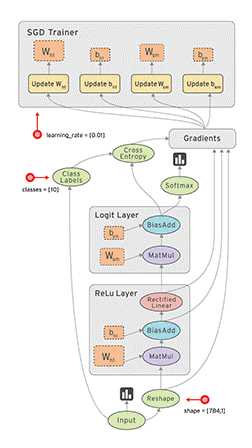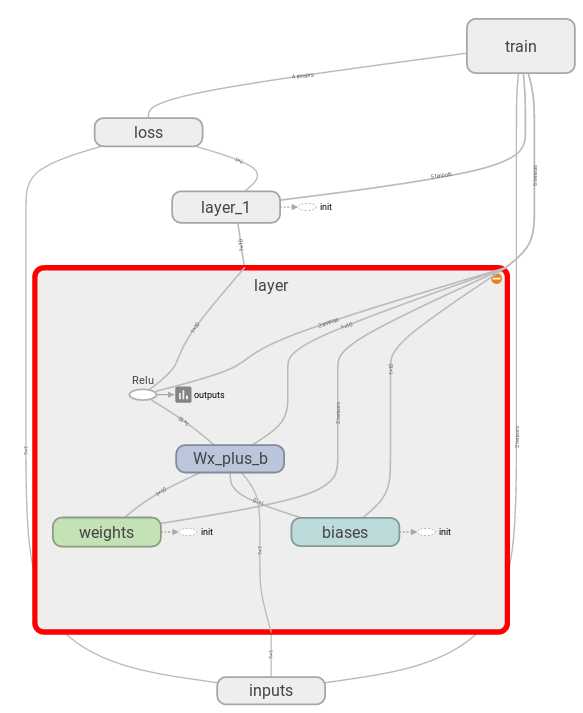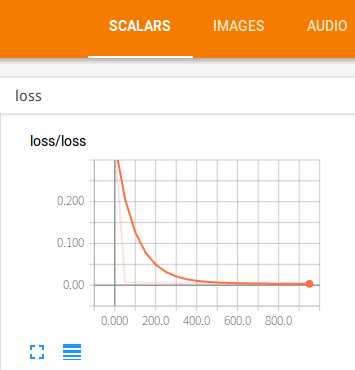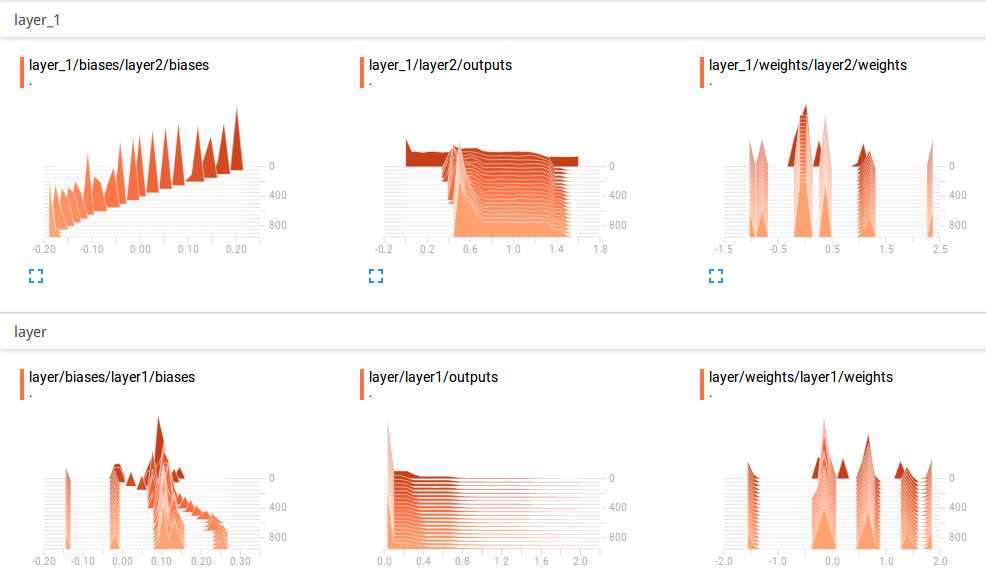标签:汇总 shape tput hidden 分布图 tmp 过程 实例 ati
PPT设计原则中有这样一条,叫“文不如表,表不如图”,可见图表在表达中更为直观、明确。程序设计中也是一样,我们经常用图表来描述程序的结构和流程,本文所述的Tensorboard就是Tensorflow提供的一款强大的可视化工具,可以借助图表更方便地进行Tensorflow程序的理解、调试和优化。

左面的数据流图cool吗?它是Tensorflow官网上给出的demo,下面,本文就结合一个具体的例子,介绍下Tensorboard的基本使用。
Tensorboard的使用可大体归结为如下几步:
1) 在构建graph的过程中,记录你想要追踪的Tensor
2) Session会话运行上一步骤中的记录
3) 查看可视化效果
那么如何具体操作呢?先走一波示例代码,一个用三层神经网络实现回归问题的小例子
1 import tensorflow as tf 2 import numpy as np 3 import matplotlib.pyplot as plt 4 5 def add_layer(inputs, in_size, out_size, n_layer, activation_function = None): 6 # add one more layer and return the output of this layer 7 layer_name = ‘layer%s‘ % n_layer 8 with tf.name_scope(‘layer‘): 9 with tf.name_scope(‘weights‘): 10 Weights = tf.Variable(tf.random_normal([in_size, out_size]), name = ‘W‘) 11 tf.summary.histogram(layer_name + ‘/weights‘, Weights) 12 with tf.name_scope(‘biases‘): 13 biases = tf.Variable(tf.zeros([1,out_size]) + 0.1, name = ‘b‘) 14 tf.summary.histogram(layer_name + ‘/biases‘, biases) 15 with tf.name_scope(‘Wx_plus_b‘): 16 Wx_plus_b = tf.add(tf.matmul(inputs, Weights), biases, name = ‘Wpb‘) 17 if activation_function is None: 18 outputs = Wx_plus_b 19 else: 20 outputs = activation_function(Wx_plus_b) 21 tf.summary.histogram(layer_name + ‘/outputs‘, outputs) 22 return outputs 23 24 #define placeholder for inputs 25 with tf.name_scope(‘inputs‘): 26 xs = tf.placeholder(tf.float32, [None, 1], name = ‘x_input‘) 27 ys = tf.placeholder(tf.float32, [None, 1], name = ‘y_input‘) 28 29 # make up some real data 30 x_data = np.linspace(-1.0, 1.0, 300, dtype = np.float32)[:,np.newaxis] 31 noise = np.random.normal(0.0, 0.05, x_data.shape) 32 y_data = np.square(x_data) + 0.5 + noise 33 34 # add hidden layer and output layer 35 l1 = add_layer(xs, 1, 10, n_layer = 1, activation_function = tf.nn.relu) 36 prediction = add_layer(l1, 10, 1, n_layer = 2, activation_function = None) 37 38 # the error between prediction and real data 39 with tf.name_scope(‘loss‘): 40 loss = tf.reduce_mean(tf.reduce_sum(tf.square(ys - prediction), reduction_indices = [1]), name = ‘L‘) 41 tf.summary.scalar(‘loss‘, loss) 42 with tf.name_scope(‘train‘): 43 train_step = tf.train.GradientDescentOptimizer(0.1).minimize(loss) 44 45 init = tf.initialize_all_variables() 46 with tf.Session() as sess: 47 sess.run(init) 48 fig = plt.figure() 49 ax = fig.add_subplot(1,1,1) 50 ax.scatter(x_data, y_data) 51 plt.show(block = False) 52 merged =tf.summary.merge_all() 53 writer = tf.summary.FileWriter(‘/tmp/tensorlogs/ex5‘, sess.graph) 54 for i in range(1000): 55 sess.run(train_step, feed_dict = {xs : x_data, ys : y_data}) 56 if i % 50 == 0: 57 # print(i, sess.run(loss, feed_dict = {xs : x_data, ys : y_data})) 58 try: 59 ax.lines.remove(lines[0]) 60 except Exception: 61 pass 62 result, prediction_value = sess.run([merged, prediction], feed_dict = {xs : x_data, ys : y_data}) 63 lines = ax.plot(x_data, prediction_value, ‘r-‘, lw = 5) 64 plt.pause(0.1) 65 writer.add_summary(result, i)
下面具体分解上述的3个步骤
1) 在上述示例中用了tf.summary.histogram()和tf.summary.scalar()记录要追踪的Tensor,前者可汇总和记录标量数据,如41行的loss;后者可汇总和记录变量为直方图,如11行的Weights。此外,tf.summary还可汇总记录图片(images),音频(Audio)等内容。
2) 在Session中运行之前,要将上述所有汇总记录做一个合并,以便统一运行,如52行的merged所示,还要指定运行后存放数据记录的日志文件的位置,如53行的writer所示。接下来,就可以通过运行获取数据记录了,如62行的result所示,这里为了简洁,将result和prediction_value放在了一起运行,也可以拆成两行执行。程序要进行多次训练,如54行的for所示,每隔50次记录下追踪数据,如56行if所示,每次记录通过writer.add_summary()添加到日志文件中。
3) 程序运行结束后,打开终端,输入tensorboard --logdir=‘path‘,其中的path为指定的日志文件存放路径,如53行‘/tmp/tensorlogs/ex5‘,运行后会看到下图所示

在浏览器的地址栏中输入上图中所示的地址http://David:6006,就会看到如下图所示的tensorboard图表:
graph: 程序图的结构

scalars: 损失函数的值随着训练次数的增加逐步下降

distributions: 隐藏层和输出层参数的分布图

histograms: 隐藏层和输出层参数的直方图

tensorboard的使用对于程序的理解、分析和优化都很有帮助,本文结合一个小的程序例子介绍了tensorboard的基本使用,更多内容可参看官方文档中关于Mnist数据集的代码实例。本文的实验环境为ubuntu16.04+tensorflow1.1。
标签:汇总 shape tput hidden 分布图 tmp 过程 实例 ati
原文地址:http://www.cnblogs.com/David-Wei/p/6984898.html